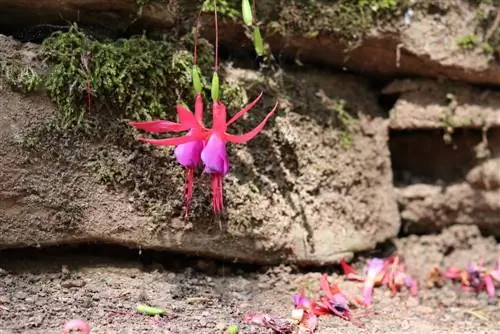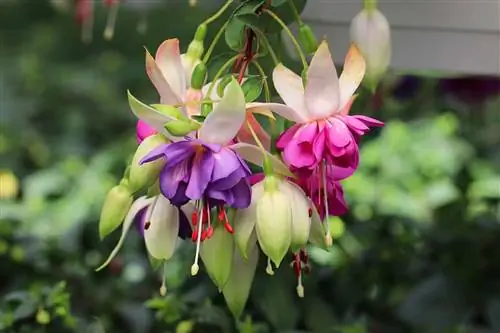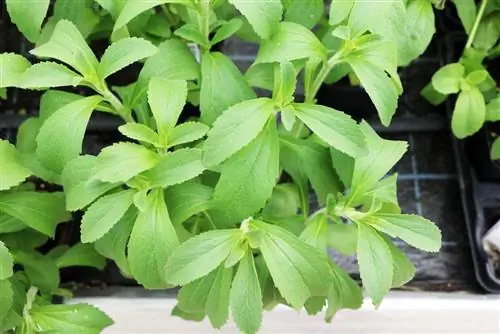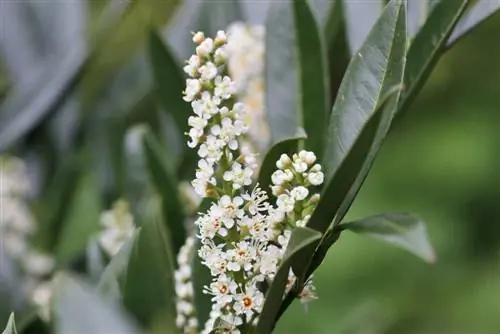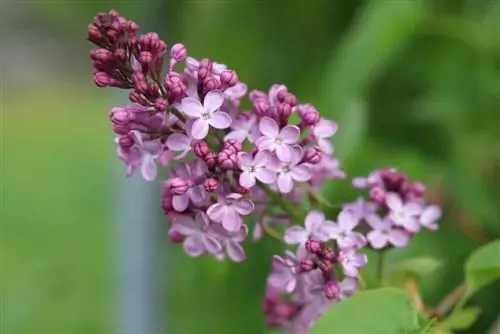- Author admin [email protected].
- Public 2023-12-17 03:39.
- Last modified 2025-01-24 12:45.
The special thing about fuchsias is undoubtedly the multi-colored flowers, which resemble a chandelier in shape, which make even shady areas in the garden or on the balcony green and bloom. The appearance of these plants can vary significantly depending on the species. In our latitudes you will mainly find bushes with different branches. But they are also available as low-growing varieties and even as meter-high trees. With the otherwise easy-care evening primrose family, there are a few things to consider, especially when overwintering.
Preparing for winter storage
As a rule, only frost-sensitive fuchsia species need to be prepared for overwintering. Fuchsias are often only kept for one year and are disposed of after they have faded. But that doesn't have to be the case, because overwintering is possible and definitely worth it, and not just for fuchsia lovers. These flowering plants are like a good wine; the older and more woody they become, the more beautiful and valuable they become.
In order to get them ready for the winter, fertilization is stopped completely from August onwards. This means that the shoots mature before winter, which in turn makes it easier for them to overwinter. From around mid-September the water supply will also be reduced. However, the bale should never dry out completely. Basically, you shouldn't put away fuchsias too early and leave them outside for as long as possible. This promotes its woodiness and it loses its leaves in a completely natural way. Other important measures before wintering include vigorous pruning and pest control.
Pruning before wintering
Before wintering, we recommend cutting back the fuchsia, which can also be more severe. Basically, the more woody these plants are, the less they should be cut. First, cut out all bent and weak shoots. The remaining ones are shortened by about a third. If this is not done, it may happen that the plants do not form any buds the following spring and therefore the flowers do not bloom. In addition, withered flowers as well as rotten, dead and diseased leaves should be completely removed.
Tip:
If you don't want to prune before wintering, you should at least shorten the soft shoots and remove leaves, flowers, buds, fruits and fruit heads. You can try to peel off the leaves. Leaves for which this is not possible can be cut off except for a small stump.
Check for pest infestation
A pest infestation that is not discovered before winterization can severely impact the plant throughout the winter. This makes meticulous checks all the more important before moving to winter quarters.
- Control for both pests and diseases such as fuchsia rust
- If there is an infestation, fight or treat it immediately
- Spray plants affected by fuchsia rust with a suitable contact fungicide
- Systemic agents are ineffective because they are only absorbed through the leaves
- The contact fungicide kills the spores of these fungi
- Remove dead plant residue from the plant and substrate before wintering
- This also applies to the entire duration of wintering
- This is how fungal infestation can be effectively prevented
- Assuming the conditions in the winter quarters meet the needs of the fuchsias
Tip:
To prevent diseases such as fuchsia rust or gray mold from spreading, you can spray the plants preventatively with products containing rapeseed or paraffin oil. Or you can spray them with an appropriate fungicide shortly before or shortly after planting.
Proper care in winter
The fuchsias go into a kind of resting phase in winter. But even now they can't survive without care. The water supply is significantly reduced, but the substrate must neither dry out completely nor be too moist in winter, both of which the fuchsia cannot tolerate. Fertilizer is completely avoided during this time because the plants do not absorb any nutrients during their rest phase.
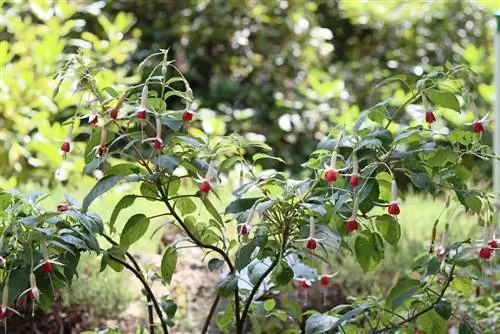
Falling leaves should always be removed completely and promptly in order to prevent fungal infestation, to which this plant is particularly susceptible at this time. In addition, the winter quarters should be ventilated regularly and the plants should not be too close together, because the air must be able to circulate well between the individual plants at all times.
Lack of light combined with temperatures that are too warm often encourages fuchsias to form so-called horny shoots. These long, thin, pale and weak shoots have to be removed again and again.
Suitable winter quarters
Non-hardy fuchsias should be brought into the house before the first night roasting, but at the latest when the outside temperature drops to zero degrees at night.
- Bright and cool rooms offer optimal conditions for wintering
- If possible, they should be heated and ventilated and provided with shade
- Greenhouses and winter gardens are therefore very suitable
- Dry basements and attics are also suitable
- Or other uninhabited, cool but frost-free rooms
- Temperatures in winter quarters should be between 5 and 10 degrees
- It shouldn't be warmer than 10 degrees
- The darker the area, the cooler it should be
- Non-woody young plants, hybrids and winter-flowering varieties are particularly sensitive
- You should be as bright as possible and a little warmer
- They should also be unpruned and overwintered with leaves
- For these sensitive plants, temperatures between 10 and 14 degrees are recommended
- Can also be overwintered in living rooms if necessary
- A window seat without direct sunlight is ideal for them
No matter what kind of room you use for the winter, it should always be well ventilated when the weather is frost-free in order to minimize the risk of fungal diseases. In addition, the pots should not be placed directly on the cold ground as they would become too cold. It's best to place them on Styrofoam, a wooden pallet or something similar. If you have several plants, you should also make sure that they are not too close together, because the air should be able to circulate easily between the individual plants at all times.
Renting as a place to spend the winter
An alternative to the winter quarters mentioned is renting fuchsias, which is only suitable for older, well-woody plants. There is no need for maintenance at all. When rented, the fuchsias are overwintered in so-called earth rents or earth pits, like those known from storing potatoes or other root vegetables. To create such a rental, you first look for a place with a low groundwater table that is protected from flooding or heavy rain. The size depends on the number of plants to be stored. It should be between 60 and 80 cm deep.
To protect against voles, the walls and floor of the pit are first lined with a close-meshed wire mesh and then with formwork boards. Then place the plants to be overwintered, including their pots, close together in the soil and cover them with straw or a layer of leaf humus at least 10 cm thick. Finally, cover the pit at ground level with boards and a sturdy foil. The film should be spread over the boards in an overlapping manner to protect the plants from rain and meltwater.
Tip:
About two weeks before you rent the plants, they should be cut back heavily. The resulting interfaces must be completely dry.
Overwinter tall trees in plastic bags
Plastic bags offer a particularly space-saving option for overwintering. It is particularly suitable for standard trees, but can also be used for all other growth forms. This method has the advantage that the soil in the pot usually remains evenly moist. However, the substrate may need to be watered minimally every 1-2 weeks, depending on the soil moisture.
- Substrate is only slightly moistened and the pot is placed in the bag
- Transparent plastic bags or garbage bags are very suitable
- Mold control is possible here at any time without having to remove the film
- The soil should be a little drier rather than too moist but still not dry out
- Wrap the bag around the shoots or trunk as close to the ground as possible and knot it
- It should be as airtight as possible
- Then place the plants in a bright and, above all, cool room
- Warm rooms unsuitable for this type of wintering
- Here, mold would form in no time
- With this form of wintering, regular mold checks are essential
- To avoid this, remove the film briefly on frost-free days and ventilate the whole thing well
Winter fuchsias
Fuchsias should be put away as late as possible and cleared out again as early as possible. When overwintering fuchsias, you should proceed very carefully and accustom them to the changed conditions very slowly. Above all, strong temperature fluctuations must be avoided at all costs. At the end of February/beginning of March you can start slowly watering a little more again. As long as the plants have not yet sprouted, they should not be too moist. When the first green can be seen, you can slowly water normally again and start fertilizing.
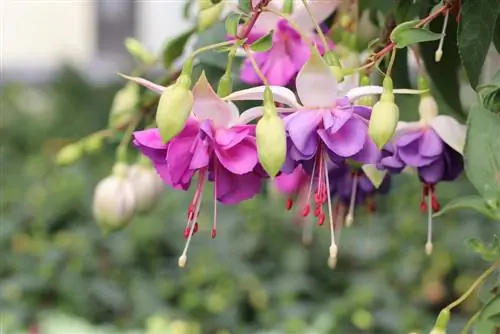
Specimens that have been overwintered in plastic bags are removed from the bags. Other plants that were overwintered dark and cool can now be placed a little brighter and warmer again. However, you should avoid direct sunlight because the leaves of these fuchsias are still very sensitive and could be damaged. Plants that have spent the winter in soil can remain there until April and then be brought back into the daylight.
From around April, most fuchsias can go outside in a partially shaded, sheltered spot during the day or at least for a few hours. As long as night or late frosts are expected, they should go back into the house in the evening. In this way, you can gradually extend your stay outside until you can finally stay outside after the Ice Saints, i.e. from mid-May.
Tip:
If the fuchsias were not pruned before wintering, you should do so now in the spring.
Winter protection for outdoor fuchsias
In addition to the fuchsia species that have to be kept frost-free over the winter, there are also a few that can be cultivated in the garden all year round without any problems, so-called outdoor fuchsias. However, these fuchsias can only tolerate low temperatures below zero, so the above-ground parts freeze back or die completely and only the roots overwinter in the ground. They usually sprout again next spring. However, these specimens cannot survive without winter protection. You can protect both the plant and the root area with a cover made of straw, brushwood or mulch.
It can also make sense to plant evergreen, dense ground cover plants around the fuchsia, which provide additional protection from the cold and protect against freezing. Particular caution is required when the first shoots appear in spring, as they are very sensitive to night and late frosts. You can easily protect them from this by placing a bucket upside down over the fuchsias.
Conclusion
Many hobby gardeners regularly throw away fuchsias that have faded and buy new ones. But that's exactly what you shouldn't do, because these plants become more and more beautiful as they get older. There are now real lovers for these beauties. Even if overwintering seems difficult, it is quite easy due to the variety of options and compared to other container plants. And when they produce their unique flowers from spring to autumn, all your troubles are forgotten.

